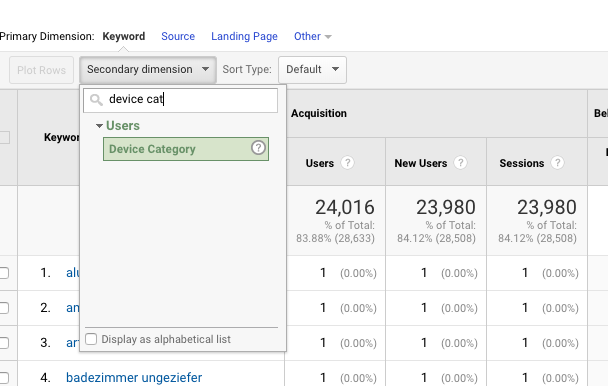Improve Your Information Evaluation with Secondary Dimension in Google Analytics
Improve Your Information Evaluation with Secondary Dimension in Google Analytics
Blog Article
Make The Most Of Coverage Accuracy With Second Dimension in Google Analytics
Understanding exactly how to make the most of reporting accuracy with additional dimensions in Google Analytics can substantially enhance the depth of insights derived from data analysis. By incorporating secondary measurements purposefully, online marketers can uncover covert patterns and correlations that may not be immediately apparent when evaluating primary metrics alone.
Recognizing Second Measurements in Google Analytics
To improve data evaluation and gain much deeper understandings into user behavior, recognizing secondary measurements in Google Analytics is vital. Secondary dimensions permit individuals to segment and further study information beyond the key measurement picked. By including additional dimensions, experts can improve their reports to reveal more detailed details regarding user communications on a web site. While the main dimension might display the complete number of page views, adding a secondary measurement such as 'source/medium' can supply understandings into where the website traffic originated from. This extra layer of info allows marketing experts to assess the performance of various marketing projects or networks in driving web traffic to the internet site.
Moreover, comprehending second measurements is crucial for producing extra customized reports tailored to certain service goals. By choosing the ideal mix of primary and secondary measurements, experts can reveal patterns, fads, and correlations that might or else continue to be hidden. This nuanced method to data analysis equips services to make enlightened choices based upon an extensive understanding of user habits across various dimensions.

How to Use Second Measurements
When leveraging secondary measurements in Google Analytics, the sensible application involves selecting particular data criteria to further fine-tune insights beyond the main measurement's extent. To use second measurements successfully, start by accessing the record or dataset where you desire to dig much deeper into the data. Within Google Analytics, find the main measurement that you are presently assessing. Once identified, click on the dropdown menu labeled "Secondary Dimension." This activity will disclose a checklist of additional parameters that can be included in your analysis. Pick the second measurement that straightens with your logical goals, such as 'Source/Medium,' 'Gadget Classification,' or 'Place.' By picking an additional dimension, you can gain a lot more thorough understandings right into individual habits, demographics, or acquisition channels. Keep in mind that second measurements help give context and granularity to your key measurement data, enabling you to remove even more actionable and meaningful understandings from your Google Analytics records.
Leveraging Additional Dimensions for Insights
Making use of additional measurements in Google Analytics permits a more comprehensive evaluation of information, providing beneficial understandings beyond the primary measurement's range. By leveraging secondary measurements, users can dig much deeper into the efficiency metrics of their site or application, discovering surprise patterns and trends that might not be right away apparent when only checking out key dimensions.
One secret benefit of making use of secondary dimensions is the capability to section and filter information extra precisely. This can help marketing experts and analysts much better recognize the actions of specific user sections, such as brand-new site visitors versus returning site visitors, or website traffic originating from various geographical areas.
Furthermore, second measurements make it possible for customers to contrast and comparison numerous information factors within the very same record, supplying a much more alternative view of efficiency (Secondary Dimension in Google Analytics). Pairing the primary measurement of landing pages with second measurements like gadgets or demographics can expose which pages are most reliable in involving individuals on different tools or from different check that group groups.
Essentially, leveraging second measurements in Google Analytics empowers customers to remove richer insights from their data, causing more enlightened decision-making and inevitably, improved efficiency.
Finest Practices for Additional Dimensions
When assessing information in Google Analytics, incorporating additional measurements effectively boosts the deepness of understandings acquired from the key metrics. Picking relevant additional measurements aids in providing context and a clearer understanding of the other information being examined.
Moreover, it is advised to restrict the number of secondary dimensions utilized in a single record to stay clear of frustrating the analysis with excessive info. Concentrating on a couple of vital secondary dimensions each time can cause even more concentrated and workable understandings. Furthermore, take into consideration experimenting with different combinations of second and primary dimensions to uncover unique trends and patterns that may not be obvious when considering the information in seclusion.
Advanced Evaluation Methods With Additional Measurements
Exploring intricate data connections via the tactical application of secondary measurements can unveil nuanced understandings that boost the deepness of analysis in Google Analytics. By integrating second dimensions with primary information collections, sophisticated analysis strategies can be utilized to draw out beneficial details.
In addition, secondary measurements can enhance the evaluation of conversion paths by offering extra context. Comprehending the different touchpoints a user communicates with prior to transforming can be essential in maximizing the consumer journey - Secondary Dimension in Google Analytics. By using secondary dimensions to look into specifics such as traffic resources or tools made use of, online marketers can tailor techniques to target high-converting networks successfully
Final Thought

To improve data analysis and gain deeper understandings right into customer habits, recognizing additional measurements in Google Analytics is critical - Secondary Dimension in Google Analytics. Secondary dimensions enable users to sector and additionally explore data past the main measurement picked. While the primary measurement might show the overall navigate here number of page views, including an additional dimension such as 'source/medium' can give insights into where the website traffic originated from.When leveraging secondary dimensions in Google Analytics, the sensible application includes picking specific data parameters to more refine insights past the primary dimension's range. Bear in mind that additional dimensions assist give context and granularity to your key measurement data, allowing you to extract more significant and workable understandings from your Google Analytics reports
Report this page